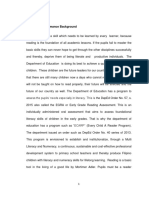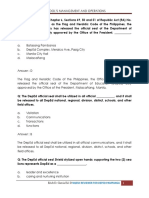Kemp Design Model
Uploaded by
Ana AriesgurlKemp Design Model
Uploaded by
Ana AriesgurlKemp Design Model
The Kemp Design Model consists of 9 steps: 1. Identify instructional problems, and specify goals for designing an instructional program. 2. Examine learner characteristics that should receive attention during planning. 3. Identify subject content, and analyze task components related to stated goals and purposes. 4. State instructional objectives for the learner. 5. Sequence content within each instructional unit for logical learning. 6. Design instructional strategies so that each learner can master the objectives. 7. Plan the instructional message and delivery. 8. Develop evaluation instruments to assess objectives. 9. Select resources to support instruction and learning activities.
Gary Morrison: About the Model
I think there are two things that are taken for granted by designers (the first of which I just observed yesterday in an email). First, you must define the instructional problem. I have seen designers jump in when management has stated there is a problem without a) confirming the problem exists or b) at least doing a goal analysis to obtain agreement on the outcomes which can also disrupt the plans. For example, I observed a case yesterday where the company was pushing very frequent training to their financial advisors and the advisors were resisting the training. The rationale I received was that the products are continually changing. I am not sure any type of analysis was done. It appears they were doing training because training was probably needed. In reality, a job aid or simply a bulletin might have been more effective and time and resource smart. Part of the problem may have been related the second issue. Second, when I asked me students at the end of the design class which step of the process had little impact on their design and they might skip in future projects, it is almost always the learner analysis step. If you look at what we know about learner analysis and then how we treat the analysis in the strategy design it is weak. We have found that learning styles have no research foundation and do not have a role in the design of instruction. The aptitudetreatment interaction studies of the past century produced no useful heuristics. Basically, learner (and environmental analysis) tend to limit our designs. Thus, learner analysis has not worked out the way we thought it would, or at least the way my professors projected in the 1970s. Today, the learner analysis limits our design such as two hours of instruction starting one hour before work rather than 40 hours of instruction in one week. Or, not all students have access to that application or a laptop computer. Then, there are specific learner characteristics that can limit instruction such as eye sight, reading level, and prior knowledge (e.g., students with all levels of background knowledge). All these characteristics are important and must be accounted for when we design instruction. I have seen too many examples of inappropriate designs that failed to account for the learner. One of the classics stories of bad learner
analysis was from a federal grant some 40 years ago. The design team created audio tapes for teachers of the deaf. Once they tried to implement the materials, they learned that a large number of the teachers were also deaf. Thus, learner analysis may not be as exciting as say a needs assessment or task analysis, we must still do a learner analysis even though it may limit what we can do, or to look at it in a positive way, it can create some great challenges for creative designs to address the instructional problem. [From Michael M. Grant's Comparing Instructional Design Models]
Additional Information
You can learn more about the Kemp Design Model by going to the folowing sites:
You might also like
- Learning Needs Assessment of Non-TeachingNo ratings yetLearning Needs Assessment of Non-Teaching9 pages
- The Partial Inclusion of Students With Special Educational Needs in The Regular Classroom at Jocson CollegeNo ratings yetThe Partial Inclusion of Students With Special Educational Needs in The Regular Classroom at Jocson College5 pages
- Organization Is The Foundation Upon Which The Whole Structure of Management Is Built100% (1)Organization Is The Foundation Upon Which The Whole Structure of Management Is Built2 pages
- PLC Presentation Formative Assessment (Autosaved)No ratings yetPLC Presentation Formative Assessment (Autosaved)39 pages
- Contingency Plan: Madapdap Resettlement High SchoolNo ratings yetContingency Plan: Madapdap Resettlement High School12 pages
- Project-Proposal-for-Innovation-in-Schools-write UpsNo ratings yetProject-Proposal-for-Innovation-in-Schools-write Ups16 pages
- Action Research 2019-2020 Arra C. Derige and Marlou A. DerigeNo ratings yetAction Research 2019-2020 Arra C. Derige and Marlou A. Derige10 pages
- Ci-Based Action Rsearch in Reading FinalNo ratings yetCi-Based Action Rsearch in Reading Final67 pages
- Mangino Elem Project An Narrative Report Onpre Test 2021 2022No ratings yetMangino Elem Project An Narrative Report Onpre Test 2021 20225 pages
- English Phonological and Phonemic AwarenessNo ratings yetEnglish Phonological and Phonemic Awareness11 pages
- An Overview: Division Education Development Plan: Asds Fredie V. AvendanoNo ratings yetAn Overview: Division Education Development Plan: Asds Fredie V. Avendano24 pages
- Personal and Professional Attributes and Interpersonal EffectivenessNo ratings yetPersonal and Professional Attributes and Interpersonal Effectiveness17 pages
- An Essay On Education - Analysis of Education System in India. What We Need To Modify?89% (9)An Essay On Education - Analysis of Education System in India. What We Need To Modify?47 pages
- VALIDATED OPCRF For SY2021 2022 - FINALNo ratings yetVALIDATED OPCRF For SY2021 2022 - FINAL11 pages
- Grades 4-12 Reading Intervention Materials Review: Washington State Evaluation ReportNo ratings yetGrades 4-12 Reading Intervention Materials Review: Washington State Evaluation Report29 pages
- Department of Education: Republic of The PhilippinesNo ratings yetDepartment of Education: Republic of The Philippines3 pages
- Learnern's With Special Educational Needs Support System Amidst Pandemic ModelNo ratings yetLearnern's With Special Educational Needs Support System Amidst Pandemic Model8 pages
- School Environment and School Heads Managerial SkillsNo ratings yetSchool Environment and School Heads Managerial Skills19 pages
- Office Performance Commitment and Review Form (OPCRF)No ratings yetOffice Performance Commitment and Review Form (OPCRF)13 pages
- Column Article Re Issues in Philippine Education by Herman LagonNo ratings yetColumn Article Re Issues in Philippine Education by Herman Lagon5 pages
- Be It Enacted by The Senate and The House of Representatives of The Philippines in Congress AssembledNo ratings yetBe It Enacted by The Senate and The House of Representatives of The Philippines in Congress Assembled12 pages
- Dunn and Dunn: School-Based Learning StylesNo ratings yetDunn and Dunn: School-Based Learning Styles5 pages
- Project Based Learning - Engaging in Real-World Challenges: 1, #1From EverandProject Based Learning - Engaging in Real-World Challenges: 1, #1No ratings yet
- The Effect of Eclectic Approach To The Students Reading ComprehensionNo ratings yetThe Effect of Eclectic Approach To The Students Reading Comprehension18 pages
- El Porque de Confusion Entre Preterito Indefinido y ImperfectoNo ratings yetEl Porque de Confusion Entre Preterito Indefinido y Imperfecto17 pages
- Learning Contract For Students of Compacted Material 4th Grade - English and Language Arts StandardsNo ratings yetLearning Contract For Students of Compacted Material 4th Grade - English and Language Arts Standards3 pages
- 9-Vocabulary Strategies For Secondary - 0No ratings yet9-Vocabulary Strategies For Secondary - 07 pages
- Session On Learners With Difficulty in Displaying Interpersonal Behaviors100% (2)Session On Learners With Difficulty in Displaying Interpersonal Behaviors23 pages
- Can / Be Able To Must/ Have To May/ Be Allowed To HasználataNo ratings yetCan / Be Able To Must/ Have To May/ Be Allowed To Használata2 pages
- Policy Guidelines For Teachers and School Personnel100% (1)Policy Guidelines For Teachers and School Personnel10 pages
- Factors Influencing Students' Motivation To Learning in University Utara Malaysia (UUM) : A Structural Equation Modeling ApproachNo ratings yetFactors Influencing Students' Motivation To Learning in University Utara Malaysia (UUM) : A Structural Equation Modeling Approach10 pages
- Metaphors For The Future: Key Issues/ConceptsNo ratings yetMetaphors For The Future: Key Issues/Concepts4 pages

























































































